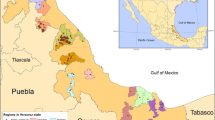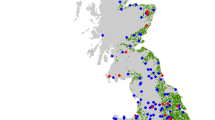Abstract
In an indigenous forest community in Palawan, Philippines, honey gathering from the giant honey bee (Apis dorsata) is a traditional subsistence practice. We characterize the social-ecological dynamics of giant honey bees with indigenous peoples of Tagbanua ethnicity using the mobile agent-based ecosystem service (MABES) framework. Chemical and pollen analysis conducted on honey samples generated data on the ecological features of this linked social-ecological system. These were supplemented by 251 household surveys and key informant interviews with institutional representatives to identify the social and institutional features of the system. Honey samples analyzed for pollen showed a total of 11 different plant families and did not have any traces of pesticide residue. The majority of households interviewed use honey as food, medicine, and a saleable commodity. A small percentage of households use fertilizers and pesticides known to be harmful to bees. Institutions have different knowledge strengths that can be tapped through a transdisciplinary approach. As the scale of production and delivery of MABES is distinctly a product of the mobility of service-delivering organisms, we recommend using a landscape approach with a focus on maintaining the quality of both the local environment and landscapes around the site of ES delivery.




Similar content being viewed by others
References
Andersson, E., Barthel, S., and Ahrné, K. (2007). Measuring social-ecological dynamics behind the generation of ecosystem services. Ecological Applications 17(5): 1267–1278.
Bargańska, Ż., Ślebioda, M., and Namieśnik, J. (2015). Honey bees and their products – Bioindicators of environmental contamination. Critical Reviews in Environmental Science and Technology 46(3): 235–248.
Berkes, F., and Folke, C. (1993). A systems perspective on the interrelationships between natural, human-made and cultural capital. Ecological Economics 5(1): 1–8.
Bernal, J., Garrido-Bailón, E., Del Nozal, M. J., et al (2010). Overview of pesticide residues in stored pollen and their potential effect on bee colony (Apis mellifera) losses in Spain. Journal of Economic Entomology 103(6): 1964–1971.
Bogdanov, S. (2006). Contaminants of bee products. Apidologie. 37: 1–18.
Bogdanov, S., Jurendic, T., Sieber, R., and Gallmann, P. (2008). Honey for nutrition and health. Journal of the American College of Nutrition 27: 677–689.
Brandt, P., Ernst, A., Gralla, F., et al (2013). A review of transdisciplinary research in sustainability science. Ecological Economics 92: 1–15.
Brown, L. D. (1991). Bridging organizations and sustainable development. Human Relations 44(8): 807–831.
Buawangpong, N., Saraithong, P., Khongphinitbunjong, K., et al (2014). The comb structure of Apis dorsata F. (Hymenoptera: Apidae): 3-dimensional architecture and resource partitioning. Chiang Mai Journal of Science 41(5.1): 1077–1083.
Buchwald, R., Breed, M. D., Greenberg, A. R., and Otis, G. (2006). Interspecific variation in beeswax as a biological construction material. The Journal of Experimental Biology 209: 3984–3989.
Campennì, M. (2016). Cognitively rich architectures for agent-based models of social behaviors and dynamics: A multi-scale perspective. In Cecconi, F. (ed.), New frontiers in the study of social phenomena, 1st edn., Springer International Publishing, Switzerland, pp. 11–40.
Di Pasquale, G., Salignon, M., Le Conte, Y., et al (2013). Influence of pollen nutrition on honey bee health: Do pollen quality and diversity matter? PLoS One 8(8): e72016.
Di Pasquale, G., Alaux, C., Le Conte, Y., et al (2016). Variations in the availability of pollen resources affect honey bee health. PLoS One 11(9): e0162818.
Estevinho, L. M., Féas, X., Seijas, J. A., and Vázquez-Tato, M. P. (2012). Organic honey from Trás-Os-Montes region (Portugal): Chemical, palynological, microbiological and bioactive compounds characterization. Food and Chemical Toxicology 50: 258–264.
FAO and WHO. (2016). Standard for honey. Codex Alimentarius International Food Standards. http://www.fao.org/fao-who-codexalimentarius/codex-texts/list-standards/en/. Accessed 17 Jan 2018
Fox, R. (1982). Religion and society among the Tagbanua of Palawan island, Philippines, National Museum, Manila.
Fromartz, S. (2007). Organic Inc: Natural foods and how they grew, Houghton Mifflin Harcourt, Florida.
Hansen, R., and Pauleit, S. (2014). From multifunctionality to multiple ecosystem services? A conceptual framework for multifunctionality in green infrastructure planning for urban areas. Ambio 43: 516–529.
Haydak, M. (1970). Honey bee nutrition. Annual Review of Entomology 15: 143–156.
Herrfahrdt-Pähle, E. (2014). Applying the concept of fit to water governance reforms in South Africa. Ecology and Society 19(1): 25.
Irungu, J., Raina, S., and Torto, B. (2016). Determination of pesticide residues in honey: A preliminary study from two of Africa’s largest honey producers. International Journal of Food Contamination 3: 14.
Kleijn, D., Winfree, R., Bartomeus, I., et al (2015). Delivery of crop pollination services is an insufficient argument for wild pollinator conservation. Nature Communications 6: 7414.
Kremen, C., Williams, N. M., Aizen, M. A., et al (2007). Pollination and other ecosystem services produced by mobile organisms: A conceptual framework for the effects of land-use change. Ecology Letters 10(4): 299–314.
Kujawski, M. W., and Namiesnik, J. (2008). Challenges in preparing honey samples for chromatographic determination of contaminants and trace residues. Trends in Analytical Chemistry 27: 785–793.
Lee, C., Jeong, S., Jung, C., and Burgett, M. (2016). Acute oral toxicity of neonicotinoid insecticides to four species of honey bee, Apis florea, A. cerana, A. mellifera, and A. dorsata. Journal of Apiculture 31(1): 51–58.
Matias, D. M. S., Leventon, J., Rau, A.-L., et al (2017a). A review of ecosystem service benefits from wild bees across social contexts. Ambio 46(4): 456–467.
Matias, D. M. S., Stellmacher, T., Borgemeister, C., Cayron, J. G., and von Wehrden, H. (2017b). Mapping giant honey bee nests in Palawan, Philippines through a transdisciplinary approach. Development in Practice 27(7): 903–912.
Maund, S. J., Campbell, P. J., Giddings, J. M., et al (2011). Ecotoxicology of synthetic pyrethroids. In Matsuo, N., and Mori, T. (eds.), Pyrethroids, 1st edn., Springer-Verlag, Berlin Heidelberg, pp. 137–165.
Milcu, A. I., Hanspach, J., Abson, D., and Fischer, J. (2013). Cultural ecosystem services: A literature review and prospects for future research. Ecology and Society 18(3): 44.
Molan, P. (1998). The limitations of the methods of identifying the floral source of honeys. Bee World 79(2): 59–68.
Odoux, J.-F., Feuillet, D., Aupinel, F., et al (2012). Territorial biodiversity and consequences on physico-chemical characteristics of pollen collected by honey bee colonies. Apidologie 43(5): 561–575.
Pahl-Wostl, C. (2009). A conceptual framework for analysing adaptive capacity and multi-level learning processes in resource governance regimes. Global Environmental Change 19: 354–365.
Philippine Statistics Authority (PSA) (2016). Philippine Standard Geographic Code. https://psa.gov.ph/populationand-housing/node/57149. Accessed 17 Oct 2019.
Philippine Statistics Authority (PSA). (2017). Updates on fertilizer prices. https://psa.gov.ph/sites/default/files/FerPrSitFeb2017.pdf. Accessed 31 March 2017
Potts, S. G., Biesmeijer, J. C., Kremen, C., et al (2010). Global pollinator declines: Trends, impacts and drivers. Trends in Ecology & Evolution 25(6): 345–353.
Rial-Otero, R., Gasper, E. M., Moura, I., and Capelo, J. L. (2007). Chromatographic-based methods for pesticide determination in honey: An overview. Talanta 71(2): 503–514.
Rist, L., Shackleton, C., Gadamus, L., et al (2016). Ecological knowledge among communities, managers, and scientists: Bridging divergent perspectives to improve forest management outcomes. Environmental Management 57: 798–813.
Sayer, J., Sunderland, T., Ghazoul, J., et al (2013). Ten principles for a landscape approach to reconciling agriculture, conservation, and other competing land uses. PNAS 110(21): 8349–8356.
Sereia, M. J., Alves, E. M., Toledo, V. A., et al (2011). Physicochemical characteristics and pollen spectra of organic and non-organic honey samples of Apis mellifera L. Anais da Academia Brasileira de Ciências 83(3): 1077–1090.
Seufert, V., Ramankutty, N., and Mayerhofer, T. (2017). What is this thing called organic? – How organic farming is codified in regulations. Food Policy 68: 10–20.
Spangenberg, J. H. (2014). Ecosystem services in a societal context. In Jacobs, S., Dendocker, N., and Keune, H. (eds.), Ecosystem services. Global issues, local practices, 1st edn., Elsevier, California.
Svensson B. 1991. Bees and trees. Working Paper 183. Swedish University of Agricultural Sciences International Rural Development Centre, Uppsala
Venturello, M. H. (1907). Manners and customs of the Tagbanuas and other tribes of the island of Palawan, Philippines. Smithsonian Miscellaneous Collections 48(4): 514–558.
Von der Ohe, W., Oddo, L. P., Piana, M. L., et al (2004). Harmonized methods of melissopalynology. Apidologie 35: S18–S25.
Wang, H., Zhang, S. W., Zeng, Z. J., and Yan, W. Y. (2014). Nutrition affects longevity and gene expression in honey bee (Apis mellifera) workers. Apidologie 45: 618.
Watanabe, M. E. (1994). Pollination worries rise as honey bees decline. Science 265: 1170.
Young, O. (2002). The institutional dimensions of environmental change, MIT Press, Cambridge.
Acknowledgments
We are grateful to Andrée Hamm, SAKTAS and the Tagbanua community of Sagpangan, Ruth Canlas, Erwin Diloy, Joanne Abrina, Loreta Alsa, Lenita Nangcod, Jun Cayron, Tanya Conlu, and Emil Robles. The first author would like to thank the German Academic Exchange Service (DAAD), the Foundation fiat panis, and The Eva Crane Trust for financial support.
Author information
Authors and Affiliations
Corresponding author
Ethics declarations
The data that support the findings of this study are available from the ZEF Data Portal https://data.zef.de/under restricted access based on the consent provided by the indigenous respondents. Data are available from the authors upon reasonable request and with permission of the representative of the indigenous Tagbanua participants.
Disclosure of Potential Conflicts of Interest
The first author was funded by the German Academic Exchange Service (DAAD), the Foundation fiat panis, and the Eva Crane Trust for this study. All the other authors do not have any potential conflicts of interest.
Research Involving Human Participants and Animals
This study has passed the Health and Security Clearance and Ethical Clearance procedure of the Center for Development Research of the University of Bonn, Germany.
Informed Consent
Free, Prior, and Informed Consent was obtained from the indigenous respondents of the study.
Additional information
Publisher’s Note
Springer Nature remains neutral with regard to jurisdictional claims in published maps and institutional affiliations.
Rights and permissions
About this article
Cite this article
Matias, D.M.S., Borgemeister, C., Sémah, AM. et al. The Role of Linked Social-Ecological Systems in a Mobile Agent-Based Ecosystem Service from Giant Honey Bees (Apis dorsata) in an Indigenous Community Forest in Palawan, Philippines. Hum Ecol 47, 905–915 (2019). https://doi.org/10.1007/s10745-019-00114-7
Published:
Issue Date:
DOI: https://doi.org/10.1007/s10745-019-00114-7




